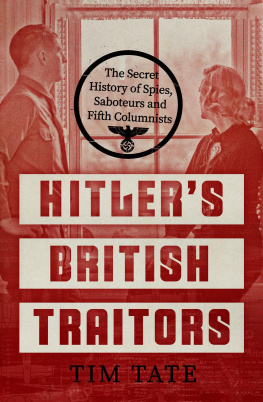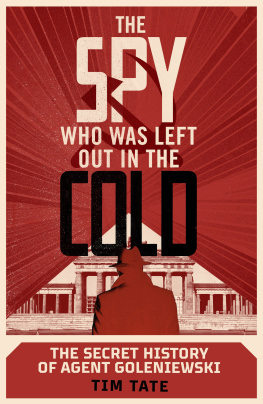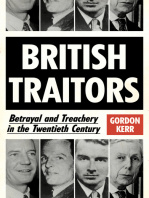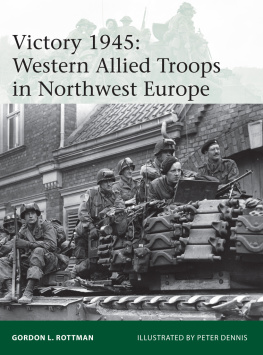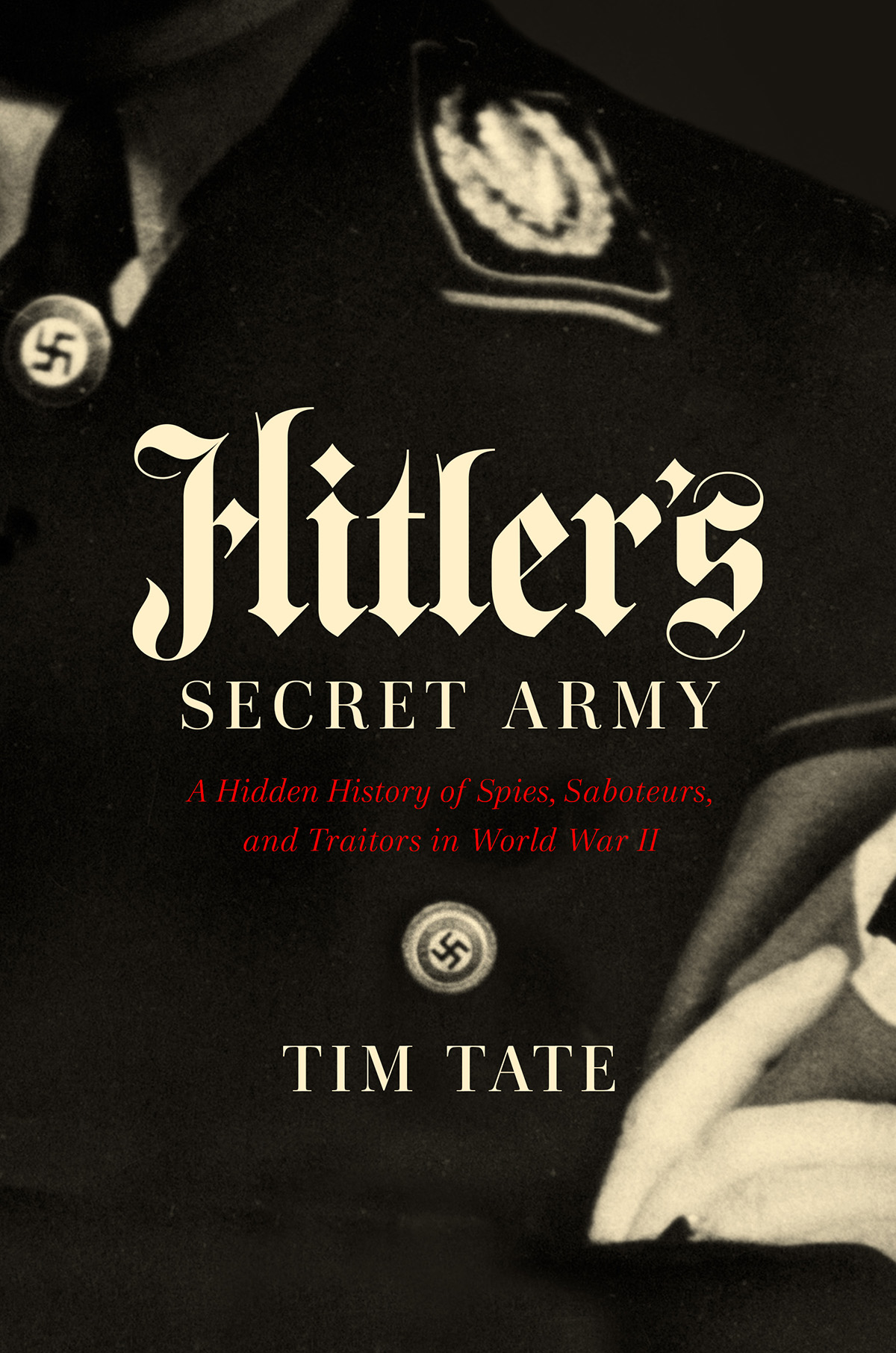Contents
Guide
Page List
HITLERS
SECRET ARMY
A Hidden History of Spies, Saboteurs, and Traitors in World War II
TIM TATE
Contents
For my children and grandchildren.
May they never have to choose between an existential threat and a moral evil.
ABOUT THE AUTHOR
Tim Tate is an award-winning documentary film-maker, investigative journalist and author of fifteen previous books of non-fiction, including the best-selling Slave Girl (John Blake, 2009) and Hitlers Forgotten Children (Elliott & Thompson, 2015) telling the story of the largely-secret Nazi Lebensborn programme through the life of one of its victims. He lives in Wiltshire.
A nation can survive its fools, and even the ambitious. But it
cannot survive treason from within. An enemy at the gates is less
formidable, for he is known and carries his banner openly.
But the traitor moves amongst those within the gate
freely, his sly whispers rustling through all the alleys,
heard in the very halls of government itself.
For the traitor appears not a traitor; he speaks in accents familiar
to his victims, and he wears their face and their arguments ...
MARCUS TULLIUS CICERO, 10643 BC
Notting Hill, West London
On the evening of Tuesday, May 28, 1940, a succession of men and women rang the bell at No. 36 Stanley Crescent, a quiet, upmarket enclave of tall, stone-faced terraces just three miles to the north of Buckingham Palace and the Houses of Parliament. They arrived one at a time and, to an attentive observer, might have seemed a little furtive.
The visitors were met at the door by a softly-spoken middle-aged man sporting a monocle, who quickly escorted them inside. He, too, seemed nervous. Each new arrival was given elaborate instructions for escaping via a back exit in the event of a raid; each time the doorbell rang, those inside the elegant drawing room moved quickly into the gardens behind the house.
The guests were a curious mixture: representatives of Londons political class mixed with members of high society and a Japanese journalist-turned-spy. When the last visitor was ushered inside, their host began issuing orders which, as their Leader, he expected to be obeyed to the letter. This was to be their final gathering: from then on each man or woman would meet only within one of eighteen watertight cells: each had 25 members. Communication was to be limited and careful; members were to speak only with the two immediate contacts in their own cell. Phone calls were discouraged, but if unavoidable, passwords were to be used by both parties to the conversation.
The Leader told his followers that a network of safe houses had been prepared to accommodate cell members dependent wives and children; none was further than ten minutes travel from the various headquarters.
In the event of serious trouble, members were to make their way to a temporary rendezvous point outside London, from where they would be escorted out of the country to Ireland, via south Wales. This route had already been successfully tested: over the previous two weeks six people had separately used it to leave Britain without attracting the attention of the authorities.
Meanwhile, the Leader himself was working hard on the next stage of the plan: the infiltration of mainstream political parties. He warned his guests that if this met opposition or proved problematic, key individuals were either to be intimidated by threats against their wives and children or bumped off.
The Leader was Dr Leigh Francis Howell Wynne Sackville de Montmorency Vaughan-Henry. To the public he was known as a celebrated composer, music critic and author; he featured regularly on the wireless, had been director of music at the Theatre Institute in Florence and had conducted orchestral performances for the royal family.
To the British Security Service, MI5, however, Leigh Vaughan-Henry was better known as a diehard fascist and violent anti-Semite. It had been monitoring him and his organisation for five years and for good reason.
The followers he had gathered round him that evening were to be the vanguard of an imminent fascist revolution: a violent coup dtat to replace the British government and the King with an authoritarian pro-Nazi regime, just as soon as German troops landed in Britain.
These men and women were part of Hitlers British Fifth Column. And they were far from alone.
T his book tells a story which has been suppressed for more than 70 years. It is the story of Hitlers British Traitors hundreds of men and women who betrayed their country to Nazi Germany during the Second World War.
They did so not on the battlefield, or within the Third Reich, but from the safety of their own homes and offices throughout Britain. They were an enemy within, willing and able to spy, commit acts of sabotage and provide information to Berlin during some of the most uncertain days of the war, when Hitlers armies were poised to invade.
Most though not all were fascists who held the same rabidly anti-Semitic beliefs as the leaders of National Socialism. Most sold out their country in the hope that Germany would win the war; some expected to receive their reward once the longed-for invasion arrived, while others sought and received more immediate payment for their treachery.
This is, however, a secret history. The official account of the Second World War dismisses the idea of a Fifth Column in Britain as either press-driven scaremongering or a diversionary tactic by the Security Service MI5 to justify an unquestionably shameful period in which thousands of enemy aliens Italian and German nationals, many of whom were Jewish refugees from Nazi persecution were interned en masse.
Papers by academic historians and legal scholars have argued in the words of the late Professor A.W.B. Simpson, one of the foremost authorities on internment that the Fifth Column was a myth and that those who believed in it during the Second World War were credulous.
Even the two authorised biographies of MI5 have adopted this version of events. The first, published by Her Majestys Stationery Office (the governments own press) in 1994, dismissed the threat of domestic enemies within as a panic;
And yet, files held by MI5, the Home Office and the Treasury Solicitors department tell a very different story. Those files, released piecemeal and in a remarkably haphazard manner to the National Archives between 2000 and 2017, show that between 1939 and 1945 more than 70 British men and women were convicted mostly in secret trials of working to help Nazi Germany win the war. Among them were Dorothy OGrady, who sabotaged military communications on the Isle of Wight and drew up detailed plans of south coast defences; George Armstrong and Duncan Scott-Ford, who passed military secrets to German Intelligence; William Gutheridge and Wanda Penlington, who cut telephone wires to obstruct the emergency services during air raids; and besides them, a small army of hardened fascists who volunteered their loyalty and their assistance to Germanys intelligence services. Four of these traitors were sentenced to death two were executed while most of the others received lengthy prison sentences.


